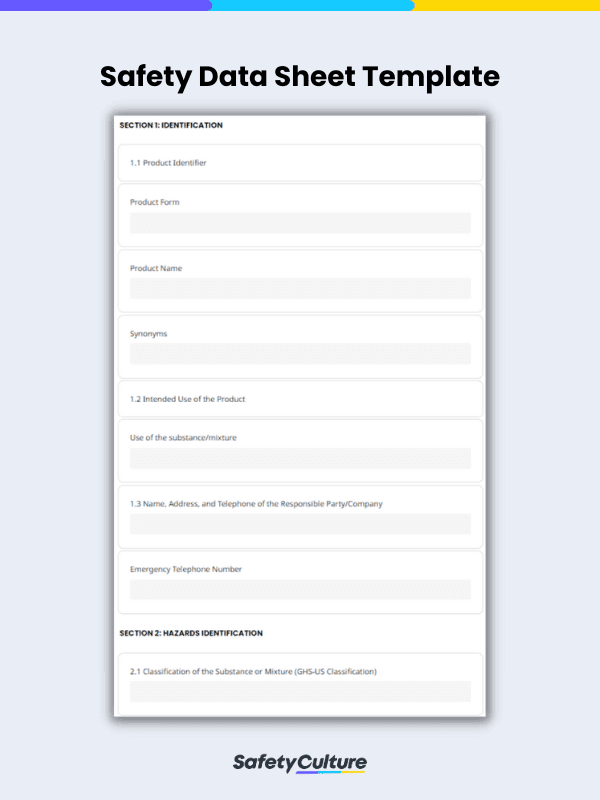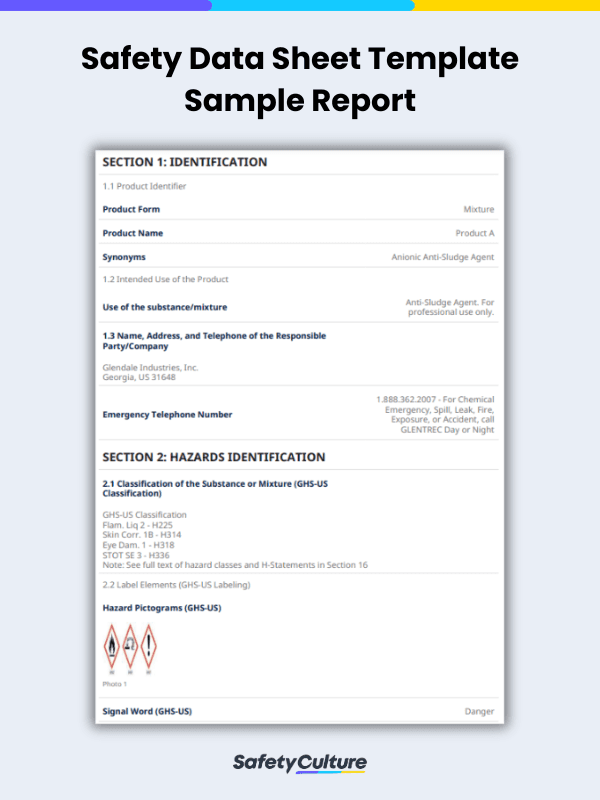What is a Safety Data Sheet Template?
A Safety Data Sheet (SDS) or Material Safety Data Sheet (MSDS) is a document that provides detailed information regarding the properties, hazards, and safe use of chemicals. It serves as an occupational safety guide for workers when handling hazardous chemicals. OSHA’s Hazard Communication Standard and Lab Safety Standard require chemical manufacturers, distributors, and importers to provide safety data sheets on the first delivery of a chemical, and upon request of the client.
Importance of Safety Data Sheets (SDS)
Safety Data Sheets (SDS) are essential for workplace safety that follows a standardized 16-section format from OSHA. Using a comprehensive template makes it easier for employees to quickly identify chemical hazards, prevent, or respond to emergency procedures. They serve as a foundational tool for training staff on chemical safety, facilitating safe handling and storage practices.
- Standardization and Compliance: Ensures all SDSs follow the required 16-section format, meeting legal and regulatory standards like GHS and OSHA.
- Complete Hazard Information: Covers all essential safety details, making hazard communication clear and thorough.
- Enhances Workplace Safety: Helps train employees and reduce risks by providing consistent, easy-to-understand safety data.
- Meets Legal Requirements: Assists manufacturers and employers in complying with laws and avoiding penalties.
- Supports Emergency Response: Provides clear instructions for first aid and firefighting, enabling quick action during incidents.
What’s Included in a Safety Data Sheet
A Safety Data Sheet follows a format implemented by Globally Harmonized System of Classification and Labelling of Chemicals (GHS), a 16-section SDS with detailed information on chemical properties, hazards, and safety measures. Here are the following key components of a safety data sheet:
1. Hazard identification (Section 2)
This section informs workers of the possible hazards to look out for when handling a specific chemical, including the degree of flammability, corrosiveness, and toxicity. Short precautionary statements are also included such as the correct protective equipment to wear and first responses in case of unwanted exposure.
2. Emergency phone number (Section 1)
Chemical manufacturers are required to include an emergency phone number on the first section of the safety data sheet. In cases of chemical emergency, spills, leaks, fires, exposure, or accidents, workers should be able to contact the manufacturer day or night for assistance.
3. First-aid measures (Section 4)
This section includes instructions on what to do in case of unwanted exposure to a given chemical. It includes first-aid measures for different entry points such as inhalation, skin contact, eye contact, and ingestion. It also includes information on acute and delayed symptoms and effects to look out for when exposed to the chemical.
4. Handling and Storage (Section 7)
This section talks about the precautions for the safe handling, storage, and transportation of hazardous chemicals. It provides instructions on what to do before, during, and after handling the chemical as well as the specifications for the container, storage condition, and incompatible products that may cause a reaction when mixed with the given chemical.
5.Exposure controls/personal protection (Section 8)
This section talks about the safety facilities and PPEs that need to be available when handling a given chemical. Examples include having emergency eye-wash fountains and safety showers on-site in case of chemical exposure, usage of explosion-proof equipment, and wearing chemically resistant fabrics.
6. Stability and reactivity (Section 10)
This provides information on the chemical’s reactivity when mixed with other elements, e.g., if it explodes when mixed with strong oxidizers. It also talks about specific conditions to avoid to prevent unwanted chemical reactions, e.g., avoid direct sunlight, extremely high or low temperatures, and other ignition sources.
7. Toxicological information (Section 11)
This section provides details regarding the chemical’s toxicity when unwanted exposure occurs. It talks about the degree of skin corrosion, eye damage/irritation, carcinogenicity, and possible consequences of single and repeated exposure to the chemical as well as symptoms and injuries that can be expected based on entry point e.g. inhalation, skin contact, or ingestion.
Safety Data Sheet Example
To give you an idea of how a completed Safety Data Sheet looks like, here’s a sample report. View the full PDF report here.
FAQs about Safety Data Sheets
Is There an Expiry Date for Safety Data Sheets SDS?
What are OSHA requirements for SDS?
Is There an Expiry Date for Safety Data Sheets SDS?




